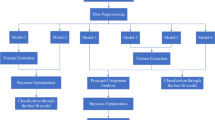Abstract
In this paper we present a wind turbine (WT) fault detection method based on ensemble learning, WT supervisory control and data acquisition (SCADA) is used for model building. In feature selection process, random forest algorithm is applied to get the feature importances, this is much convenient compared with general feature selection by experience, also more accurate result is obtain. In model building, SVM based bagging algorithm is used, compared to individual SVM, out method is much faster and again with a better result.
K. Wang—This paper is supported by Renewable Energy Research Center of China Electric Power Research Institute of STATE GRID,’s science and technology project: Research on Key Technologies of condition monitoring and intelligent early detection of wind turbine based on big data.
Access this chapter
Tax calculation will be finalised at checkout
Purchases are for personal use only
Similar content being viewed by others
References
Aziz, M.A., Noura, H., Fardoun, A.: General review of fault diagnostic in wind turbines 20(1) 1302-1307 (2010)
Amirat, Y., Benbouzid, M.E.H., Al-Ahmar, E., Bensaker, B., Turri, S.: A brief status on condition monitoring and fault diagnosis in wind energy conversion systems. RSER 13, 2629–2636 (2009)
Schlechtingen, M., Santos, I.F., Achiche, S.: Wind turbine condition monitoring based on SCADA data using normal behavior models. Part 1 system description. App. Soft Comput. 14, 447–460 (2013)
Yang, W., Court, R., Jiang, J.: Wind turbine condition monitoring by the approach of SCADA data analysis. Renew. Energy 53(9), 365–376 (2013)
Schlechtingen, M., Santos, I.F.: Wind turbine condition monitoring based on SCADA data using normal behavior models. Part 2: application examples. Elsevier Science Publishers B.V. (2014)
Santos, P., Villa, L.F., Reñones, A., Bustillo, A., Maudes, J.: An SVM-based solution for fault detection in wind turbines. Sensors 15, 5627–5648 (2015)
Odofin, S., Gao, Z., Sun, K.: Robust fault estimation in wind turbine systems using GA optimisation. Industrial Informatics (INDIN). In: 2015 IEEE 13th International Conference on IEEE, pp. 580–585 (2015)
Malik, H., Mishra, S.: Application of probabilistic neural network in fault diagnosis of wind turbine using FAST. TurbSim Simulink. Procedia Comput. Sci. 58, 186–193 (2015)
Liu, X., Li, M., et al.: A predictive fault diagnose method of wind turbine based on K-means clustering and neural networks. JIT, 17 (2016). doi:10.6138/JIT.2016.17.7.20151027i
Géron, A.: Hands-On Machine Learning with Scikit-Learn and TensorFlow: Concepts, Tools, and Techniques to Build Intelligent Systems. O’Reilly Media, Sebastopol (2017)
Statnikov, A., et al.: A Gentle Introduction to Support Vector Machines in Biomedicine. World Scientific, Singapore (2014)
Author information
Authors and Affiliations
Corresponding author
Editor information
Editors and Affiliations
Rights and permissions
Copyright information
© 2017 Springer Nature Singapore Pte Ltd.
About this paper
Cite this paper
Qin, S., Wang, K., Ma, X., Wang, W., Li, M. (2017). Ensemble Learning-Based Wind Turbine Fault Prediction Method with Adaptive Feature Selection. In: Zou, B., Han, Q., Sun, G., Jing, W., Peng, X., Lu, Z. (eds) Data Science. ICPCSEE 2017. Communications in Computer and Information Science, vol 728. Springer, Singapore. https://doi.org/10.1007/978-981-10-6388-6_49
Download citation
DOI: https://doi.org/10.1007/978-981-10-6388-6_49
Published:
Publisher Name: Springer, Singapore
Print ISBN: 978-981-10-6387-9
Online ISBN: 978-981-10-6388-6
eBook Packages: Computer ScienceComputer Science (R0)




